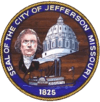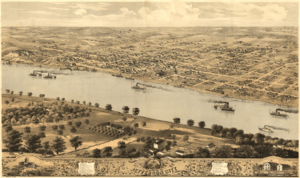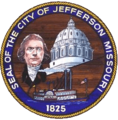Jefferson City, Missouri facts for kids
Quick facts for kids
Jefferson City
|
|||
|---|---|---|---|
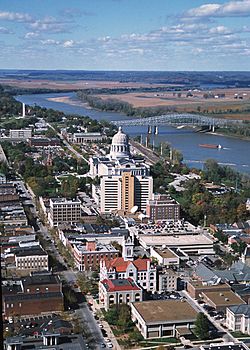 |
|||
|
|||
| Nickname(s):
Jeff City, JC, JCMO
|
|||
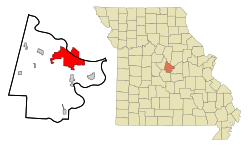 |
|||
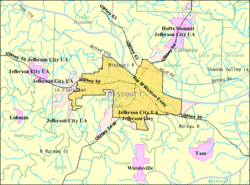
U.S. Census Map
|
|||
| Country | |||
| State | |||
| Counties | |||
| Founded | 1821 | ||
| Incorporated | 1825 | ||
| Named for | Thomas Jefferson | ||
| Government | |||
| • Type | Mayor–council | ||
| Area | |||
| • State capital | 37.65 sq mi (97.51 km2) | ||
| • Land | 36.05 sq mi (93.38 km2) | ||
| • Water | 1.60 sq mi (4.13 km2) | ||
| Elevation | 630 ft (192 m) | ||
| Population
(2020)
|
|||
| • State capital | 43,228 | ||
| • Estimate
(2024)
|
42,595 | ||
| • Density | 1,198.98/sq mi (462.93/km2) | ||
| • Metro | 149,807 | ||
| Demonym(s) | Jefferson Citian | ||
| Time zone | UTC−6 (CST) | ||
| • Summer (DST) | UTC−5 (CDT) | ||
| ZIP codes |
65101-65111
|
||
| Area code(s) | 573 | ||
| FIPS code | 29-37000 | ||
| GNIS ID | 758233 | ||
Jefferson City, often called Jeff City, is the capital city of Missouri. It is located in the United States. In 2020, about 43,228 people lived there. This makes it the 16th largest city in Missouri.
Jefferson City is also the main city of Cole County. It is a big part of the Jefferson City Metropolitan Statistical Area. This area is the second largest in Mid-Missouri. A small part of the city is in Callaway County.
The city is named after Thomas Jefferson. He was the third President of the United States. He also helped write the Declaration of Independence.
Jefferson City is in the middle of Missouri. It sits on the southern side of the Missouri River. It is between Kansas City and St. Louis. The city has a large building called the Missouri State Capitol. It stands on a bluff overlooking the Missouri River. Explorers Lewis and Clark passed by this spot in 1804.
Many people in Jefferson City work in service and manufacturing jobs. The city is also home to Lincoln University. This public university was started in 1866 by black veterans of the American Civil War.
Contents
History of Jefferson City
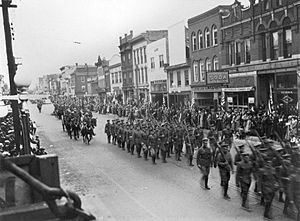
Long ago, Native American groups like the Osage lived in this area. Later, explorers like Daniel Boone came to the region. Daniel Boone's son, Daniel Morgan Boone, helped plan out Jefferson City.
In 1821, Jefferson City was chosen to be Missouri's new state capital. Before that, St. Louis and St. Charles were the capitals. The small village was first called "Lohman's Landing." Lawmakers thought about naming it "Missouriopolis." But they decided on "Jefferson" to honor former President Thomas Jefferson. Over time, everyone started calling it "Jefferson City."
The state lawmakers also chose Jefferson City for a state prison. This prison, called the Missouri State Penitentiary, opened in 1836. It was a very old and famous prison.
During the American Civil War (1861-1865), Union soldiers took over Jefferson City. Missouri was a "border state," meaning people were divided. Some supported the Union, and others supported the Confederacy.
German immigrants settled in this area in the mid-1800s. They started vineyards along the Missouri River. This region is now known as the "Missouri Rhineland." It is famous for its wineries and tourism.
2019 Tornado Event
On May 22, 2019, a strong tornado hit Jefferson City. It caused a lot of damage on the southwest side of the city. About 20 people were hurt, but thankfully, no one was killed. The tornado started near Eldon before reaching Jefferson City.
Geography and Climate
Jefferson City covers about 37.58 square miles (97.33 square kilometers). Most of this area is land, with a small part being water.
The city has a climate with hot, rainy summers and cold winters. Thunderstorms are common in spring and summer. Light snow often falls in winter, but sometimes it rains instead.
Population and People
| Historical population | |||
|---|---|---|---|
| Census | Pop. | %± | |
| 1860 | 3,082 | — | |
| 1870 | 4,420 | 43.4% | |
| 1880 | 5,271 | 19.3% | |
| 1890 | 6,742 | 27.9% | |
| 1900 | 9,664 | 43.3% | |
| 1910 | 11,850 | 22.6% | |
| 1920 | 14,490 | 22.3% | |
| 1930 | 21,596 | 49.0% | |
| 1940 | 24,268 | 12.4% | |
| 1950 | 25,099 | 3.4% | |
| 1960 | 28,228 | 12.5% | |
| 1970 | 32,407 | 14.8% | |
| 1980 | 33,619 | 3.7% | |
| 1990 | 35,481 | 5.5% | |
| 2000 | 39,636 | 11.7% | |
| 2010 | 43,079 | 8.7% | |
| 2020 | 43,228 | 0.3% | |
| 2024 (est.) | 42,595 | −1.1% | |
| U.S. Decennial Census | |||
In 2020, Jefferson City had a population of 43,228 people. The city is home to people from many different backgrounds.
Economy and Tourism
| Jefferson City's Top Employers (2016) | ||
|---|---|---|
| Rank | Employers | # of employees |
| 1 | State of Missouri | 14,223 |
| 2 | Capital Region Medical Center | 1,573 |
| 3 | Scholastic | 1,500 |
| 4 | Jefferson City Public Schools | 1,489 |
| 5 | SSM Health-St. Mary's Hospital | 1,154 |
| 6 | Central Bancompany | 967 |
| 7 | ABB Power T&D Company | 775 |
| 8 | Jefferson City Medical Group | 633 |
| 9 | Wal-Mart Supercenter | 622 |
| 10 | Unilever | 510 |
| No change reported in 2017 | ||
Jefferson City's economy depends on its residents, people from nearby towns, and tourists. Many jobs are in government, health care, and manufacturing. Retail stores, education, and tourism are also important.
Many companies have their main offices in Jefferson City. These include Central Bancompany and Capital Region Medical Center. Central Dairy, which makes dairy products, also ships its goods across the state.
Tourists enjoy visiting the Missouri State Capitol building. They also visit St. Peter Church and the Missouri Governor's Mansion. The Missouri State Penitentiary and the Missouri State Museum are popular too. Lincoln University also brings students and visitors to the city.
Education in Jefferson City
Schools
The Jefferson City Public School District runs two high schools: Jefferson City High School and Capital City High School. There are also two middle schools and eleven elementary schools.
Besides public schools, there are private elementary and high schools. These include Helias High School and Calvary Lutheran High School.
Colleges and Universities
Lincoln University is a public university in Jefferson City. It offers many different programs.
Other colleges with campuses in the city include Columbia College and William Woods University. The University of Missouri, a large state university, is about 30 miles north in Columbia.
Public Library
Jefferson City has a public library called the Missouri River Regional Library.
Media
Print and Television
The main daily newspaper in Jefferson City is the Jefferson City News Tribune. There are also several monthly magazines.
Jefferson City is part of the Mid-Missouri television market. KRCG, a CBS TV station, and KFDR, a Christian TV station, are both based in the city.
Radio
Many radio stations broadcast from Jefferson City. They play different types of music and news. Some stations are owned by universities or religious groups. Others play popular music or news and talk shows.
Transportation and Healthcare
Transportation
Major highways like U.S. Routes 50, 54, and 63 pass through Jefferson City. However, no Interstate highway goes directly through the city. The closest Interstate 70 is about 30 miles north in Columbia.
The city has the Jefferson City Memorial Airport. For longer trips, people can use Columbia Regional Airport.
For getting around the city, JeffTran offers bus service on weekdays. For travel between cities, the Jefferson City station is a stop for the Missouri River Runner train. This train runs between Kansas City and St. Louis. There is also a Greyhound bus stop for intercity travel.
Healthcare
Jefferson City has two main hospitals. These are SSM Health St. Mary's Hospital and Capital Region Medical Center. They provide healthcare services to the community.
Notable People
Sister City
Jefferson City has a sister city in Germany called Münchberg. About 200 years ago, people from Münchberg settled in Jefferson City. They created a neighborhood south of downtown that is still called "Old Munichburg."
Images for kids
See also
 In Spanish: Jefferson City para niños
In Spanish: Jefferson City para niños



